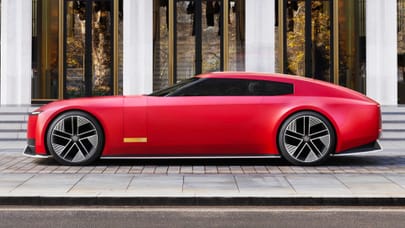
Was this Jaguar concept trolling or just good business?
The 1990 Kensington concept attempted to reinvent the XJ. But it wasn't Jaguar's…

Wait, I’ve not seen this Jaguar before

Well, it’s sort of a Jaguar and sort of isn’t. This is a concept car produced by Italian design house Italdesign (how long did it take them to come up with the name, you wonder) and shown at the 1990 Geneva and British motor shows. It’s the automotive equivalent of camping outside someone’s office until they give you a job. There’s certainly Jaguar DNA in the Kensington, but it wasn’t donated willingly...
Advertisement - Page continues belowIt’s all a bit sleek for a 1990s Jaguar, isn’t it?

The Coventry-based carmaker was stuck in a deeply conservative rut it wouldn’t escape until 2009 and the launch of the X351 XJ (the most recent one, now out of production). The headlights do look more like they belong on an E39 BMW 5 Series, which given that it didn’t arrive until 1995, could indeed have been inspired by the Kensington (but probably wasn’t). The shape of the rear lights is a call back to more traditional times at Jaguar. The flush windows along the side of the car were very modern, and the aerodynamic wing mirrors positively sporting.
Was it a working concept car, or just smoke and mirrors?

The first showing of the car was at Geneva in 1990, and that was just a static model. Fast forward to that year’s Birmingham motor show and the Kensington had been whipped into shape as a working concept car, using a Series III XJ12 as the donor car, the Eighties XJ famous for its appearances in US television's serial thriller The Equalizer. The chassis and mechanical components of the Series III were left unchanged – the front overhang was stretched by 121mm and the tail shortened by 185mm and lifted up, for a sleeker, more nose-heavy look. The roof was raised by 25mm for a bit of extra headroom in the cabin. It’s actually a formula that Jaguar would deploy 20 years later when putting together the X351 XJ – the updated headlights and grille, and the raised rear end were all deployed to devastating effect on the car that dragged Jaguar past the 1960s.
Advertisement - Page continues belowWhat’s going on under the bonnet?

Using the Series III XJ as a mule for the Kensington meant using its 5.3-litre V12 engine. This venerable block saw service from 1971 to 1997, before it was finally put out of its misery. This meant that the front-engined, rear-wheel drive Kensington produced 295bhp and a healthy 319lb ft of torque. We’re less excited about the GM-sourced three-speed auto box that also came with the Jag – still, it was enough to get the source car from 0–62mph in 7.9secs and on to a 140mph top speed, so we would expect a similar performance from the Kensington.
What about the interior?

The inside of the car was a less successful update of the Jaguar formula – there was minimal wood on display, at least, but the herd’s worth of green leather hasn’t aged well. The Kensington disguised its bulk well, but there was all the space inside the car you would expect for something of the XJ’s standard. A slightly baffling note was struck by the split front windows – if you look here you can see the line. Because who wants a fully opening window?
Any exciting concept car touches on the Kensington?

This car was less about predicting the future and more about updating the past (and trying to score a contract with Jaguar for designing the thing). That said, there was a particularly delightful party piece that Italdesign showed off at the Birmingham motor show – the key fob could not only unlock the car and start the engine, but it would also open the driver’s door at the push of a button. Fancy. The raciest part of the Kensington was no doubt the pizza pan alloys, which looked like a Lazy Susan you might have spotted at an early Nineties dinner party.
Why didn’t the Kensington concept go into production?

No one really knows, but Jaguar basically ghosted Italdesign – didn’t respond to the concept car, didn’t send a Christmas card or respond to any of their Facebook messages. Which is fair enough, they didn’t really ask for it. Instead it was business at usual at Browns Lane – the next XJ looked basically the same as the last one, with a few new bits stuck on here and there.
Advertisement - Page continues belowWhat a shame, I fancied buying one of those

You should definitely take this up with Jaguar’s customer relations department in 1990. Although, and this is one of the automotive industry’s best kept secrets, the Kensington did live on. Undeterred by its brutal rejection at the hands of Jaguar, Italdesign went looking for another suitable premium carmaker that would be happy to take on its challenge of reinventing the fancy luxo-barge for a new decade. That’ll be the Daewoo. It went into production as the new Leganza – the front end might look a bit different, but some nifty detective work reveals that the rest of the car is basically exactly the same. Minus the 5.3-litre V12, of course. Well played Italdesign, well played.
Trending this week
- Car Review
BMW 1 Series







